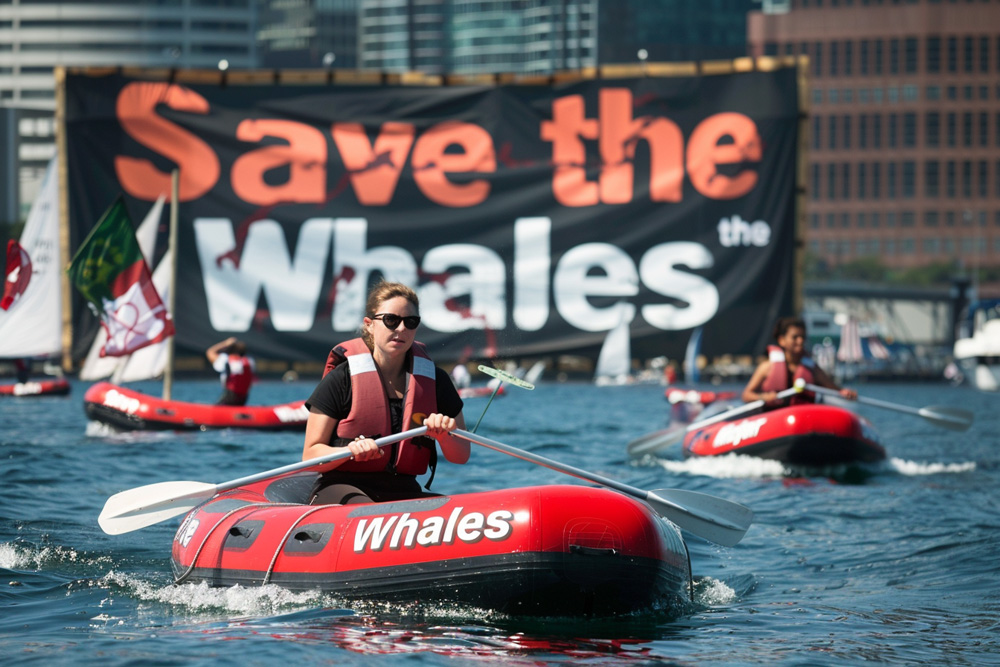KidZone Maritime History
Technological Advancements and Social Activism in Whaling
Technological Advancements in Whaling:
1. The Explosive Harpoon:
- In the 19th century, the invention of the explosive harpoon revolutionized whaling.
- Unlike traditional hand-thrown harpoons, explosive harpoons were shot from cannons mounted on whaling ships.
- These harpoons contained explosive charges that detonated upon impact, ensuring a quicker and more certain kill.
- This increased efficiency in capturing whales, significantly boosting the industry's productivity.
- However, the explosive harpoon also led to the over-exploitation of whale populations, as it allowed whalers to catch more whales in less time.
2. Steam-Powered Ships:
- The introduction of steam-powered ships in the late 19th century further advanced the whaling industry.
- Steamships were faster and more powerful than sailing vessels, allowing whalers to travel greater distances and access previously unreachable whaling grounds.
- These ships could tow multiple whales back to port, increasing the volume of oil and other products brought back from each voyage.
- The increased capacity and speed of steam-powered whalers accelerated the depletion of whale populations, pushing some species to the brink of extinction.
3. Factory Ships:
- In the early 20th century, factory ships emerged as a major technological advancement in whaling.
- These large vessels were equipped with onboard processing facilities, enabling the immediate processing of whales.
- Blubber could be rendered into oil, and meat and bones processed while still at sea.
- Factory ships extended the range and duration of whaling expeditions, contributing to unsustainable harvesting rates.
Impact on Sustainability and Beneficiaries:
- These technological advancements made whaling more efficient but less sustainable.
- The rapid increase in whale captures led to the severe depletion of whale populations, with many species becoming endangered.
- The benefits of these technological advancements were reaped by a few wealthy individuals and companies who controlled the whaling industry.
- Whalers and their communities often remained poor, despite the increased efficiency and profitability of the industry.
- The over-exploitation of whales resulted in long-term ecological damage and the disruption of marine ecosystems.
Social Activism and the Fight for Sustainability:
1. Early Conservation Efforts:
- By the early 20th century, the devastating impact of industrial whaling on whale populations became apparent.
- Some scientists and conservationists began to raise concerns about the sustainability of whaling practices.
- International conferences and agreements, such as the 1931 Convention for the Regulation of Whaling, aimed to manage and conserve whale populations, though enforcement was often weak.
2. Rise of Environmental Activism:
- The environmental movement of the 1960s and 1970s brought increased attention to the plight of whales.
- Activist groups, such as Greenpeace, launched high-profile campaigns to end commercial whaling.
- These groups used direct action tactics, including placing themselves between whaling ships and their targets, to disrupt whaling operations and draw public attention to the issue.
- The powerful imagery and media coverage of these actions galvanized public opinion against whaling.
3. International Whaling Commission (IWC):
- Established in 1946, the IWC was tasked with regulating whaling to ensure the conservation of whale populations.
- In response to mounting evidence of declining whale numbers and pressure from activists, the IWC implemented a moratorium on commercial whaling in 1986.
- This moratorium was a significant victory for the conservation movement, though some countries continued whaling under objections and loopholes for scientific research and indigenous practices.
4. Continued Advocacy and Legal Battles:
- Despite the IWC moratorium, whaling continued in some regions, leading to ongoing advocacy and legal challenges by environmental groups.
- Organizations like Sea Shepherd pursued aggressive campaigns against whaling fleets, particularly targeting Japan, Norway, and Iceland.
- Legal actions in international courts aimed to close loopholes and enforce stricter regulations on whaling practices.
Impact of Social Activism:
- Social activism played a crucial role in raising awareness about the unsustainable nature of modern whaling and the need for conservation.
- Activists succeeded in shifting public perception, making whale conservation a global priority.
- The combined efforts of scientists, conservationists, and activists led to significant policy changes, such as the IWC moratorium.
- These efforts contributed to the recovery of some whale populations, though challenges remain in ensuring the long-term sustainability of all species.
Summary:
Technological advancements in whaling, such as the explosive harpoon, steam-powered ships, and factory ships, made the industry more efficient but also less sustainable. These advancements led to the over-exploitation of whale populations and primarily benefited a few wealthy individuals and companies. Social activism, particularly from the mid-20th century onwards, played a pivotal role in challenging these unsustainable practices.
Through direct action, advocacy, and legal battles, activists helped implement crucial conservation measures, including the IWC moratorium on commercial whaling, fostering a greater global awareness and commitment to whale conservation.
Wellerman Supply Ships Activity >
